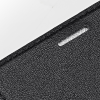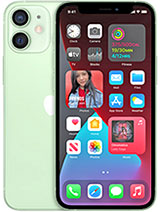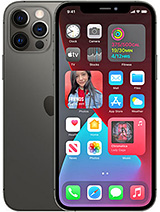To maximize your SAR comparison experience with color-coded SAR charts, please view the comparison in landscape mode. Position the top and bottom of your phone to the left and right to maximize screen size. Adding a third phone to compare is only recommended for tablets and computers with larger screens. Use the dropdown to continue.
Apple iPhone 12 Mini vs Apple iPhone 12 Pro
- Product Name
- Product Image
-
RF Protection
Apple iPhone 12 Mini SAR Level Summary:
The cellular transmission SAR values for the Apple iPhone 12 Mini (FCC ID BCG-E3539A) are 1.160 W/kg (watts per kilogram) at the head and 1.090 W/kg when worn on the body. The simultaneous transmission SAR values for Apple iPhone 12 Mini (cellular plus Wi-Fi) is 1.374 W/kg at the head, 1.505 W/kg when worn on the body, and 1.585 W/kg when used as a hotspot simultaneously with other transmitters active.
iPhone 12 Mini Radiation Safety Accessories
RF Safe® iPhone 12 Mini QuantaCase™ EMF Anti-Radiation Phone Case
Original price was: $69.99.$45.47Current price is: $45.47.
Apple iPhone 12 Pro SAR Level Summary:
The cellular transmission SAR values for the Apple iPhone 12 Pro (FCC ID BCG-E3545A) are 1.157 W/kg (watts per kilogram) at the head and 1.167 W/kg when worn on the body. The simultaneous transmission SAR values for Apple iPhone 12 Pro (cellular plus Wi-Fi) is 1.372 W/kg at the head, 1.537 W/kg when worn on the body, and 1.537 W/kg when used as a hotspot simultaneously with other transmitters active.
iPhone 12 Pro Radiation Safety Accessories
RF Safe® iPhone 12 Pro QuantaCase™ EMF Anti-Radiation Phone Case
Original price was: $69.99.$45.47Current price is: $45.47.
General
- Apple iPhone 12 MiniApple iPhone 12 Pro
-
Phone
Apple iPhone 12 Mini Apple iPhone 12 Pro
-
Technology
GSM / CDMA / HSPA / EVDO / LTE / 5G GSM / CDMA / HSPA / EVDO / LTE / 5G
-
Announced
13 October 2020 13 October 2020
-
Status
Available. Released 2020, November 13 Available. Released 2020, October 23
-
Price
$ 499.00 / € 627.10 / £ 519.00 $ 999.00 / £ 999.00
-
Model Names
A2399, A2176, A2398, A2400, A2399, iPhone13,1 A2407, A2341, A2406, A2408
Display
- Apple iPhone 12 MiniApple iPhone 12 Pro
-
Type
Display Technology => A number of display technologies and types used in mobile phones => TFT (Thin Film Transistor), IPS (In-Place Switching), OLED (Organic Light Emitting Diode), AMOLED (Active-Matrix Organic Light-Emitting Diode), Super AMOLED (an even advanced version of AMOLED), Resistive Touchscreen (Resistive touchscreens contain two layer of conductive material with a very small gap between them which acts as a resistance), Capacitive Touchsceen (Capacitive touchscreen technology consists of a layer of glass coated with a transparent conductor) Super Retina XDR OLED, HDR10, Dolby Vision, 625 nits (HBM), 1200 nits (peak) Super Retina XDR OLED, HDR10, 800 nits (typ), 1200 nits (peak)
-
Size
5.4 inches, 71.9 cm2 (~85.1% screen-to-body ratio) 6.1 inches, 90.2 cm2 (~86.0% screen-to-body ratio)
-
Resolution
1080 x 2340 pixels, 19.5:9 ratio (~476 ppi density) 1170 x 2532 pixels, 19.5:9 ratio (~460 ppi density)
-
Protection
Display Protection => Gorilla Glass is a special alkali-aluminosilicate glass shield with exceptional damage resistance that helps protect mobile displays from scratches, drops, and bumps of everyday use, It is always better to go for a smartphone with Gorilla Glass for that added protection and peace of mind. Scratch-resistant ceramic glass, oleophobic coating Scratch-resistant ceramic glass, oleophobic coating
-
Features
Scratch-resistant ceramic glass, oleophobic coating Wide color gamutTrue-tone Scratch-resistant ceramic glass, oleophobic coating Dolby VisionWide color gamutTrue-tone
-
Display Test
Contrast ratio: Infinite (nominal) Contrast ratio: Infinite (nominal)
Camera
- Apple iPhone 12 MiniApple iPhone 12 Pro
-
Main Camera
Camera is able to capture photographs and usually videos, The most important characteristics of a camera are the resolution (measured in megapixels), lens focus type (fixed or automatic), higher megapixel cameras are known to capture higher quality photos, but not always a good measurement of the photos quality. Dual Camera: 12 MP, f/1.6, 26mm (wide), 1.4m, dual pixel PDAF, OIS
12 MP, f/2.4, 13mm, 120 (ultrawide), 1/3.6" Quad Camera: 12 MP, f/1.6, 26mm (wide), 1.4m, dual pixel PDAF, OIS
12 MP, f/2.0, 52mm (telephoto), 1/3.4", 1.0m, PDAF, OIS, 2x optical zoom
12 MP, f/2.4, 120, 13mm (ultrawide), 1/3.6"
TOF 3D LiDAR scanner (depth) -
Main Features
Dual-LED dual-tone flash, HDR (photo/panorama) Dual-LED dual-tone flash, HDR (photo/panorama)
-
Video
4K@24/30/60fps, 1080p@30/60/120/240fps, HDR, Dolby Vision HDR (up to 30fps), stereo sound rec. 4K@24/30/60fps, 1080p@30/60/120/240fps, 10bit HDR, Dolby Vision HDR (up to 60fps), stereo sound rec.
-
Selfie Camera
Dual Camera: 12 MP, f/2.2, 23mm (wide), 1/3.6"
SL 3D, (depth/biometrics sensor) Dual Camera: 12 MP, f/2.2, 23mm (wide), 1/3.6"
SL 3D, (depth/biometrics sensor) -
Selfie Camera Features
HDR HDR
-
Selfie Camera Video
4K@24/30/60fps, 1080p@30/60/120fps, gyro-EIS 4K@24/30/60fps, 1080p@30/60/120fps, gyro-EIS
Battery
- Apple iPhone 12 MiniApple iPhone 12 Pro
-
Type
Battery Type => Cell phones run on various kinds of batteries depending on the manufacturer, phone size or shape and features. There are basically four types of cell phone batteries => Lithium Polymer, Lithium Ion, Nickel Metal Hydride and Nickel Cadmium. Li-Ion 2227 mAh, non-removable (8.57 Wh) Li-Ion 2815 mAh, non-removable (10.78 Wh)
-
Battery Test
Battery Capacity is a measure (typically in Amp-hr) of the charge stored by the battery, and is determined by the mass of active material contained in the battery. The battery capacity represents the maximum amount of energy that can be extracted from the battery under certain conditions. Endurance rating 69h Endurance rating 81h
-
Charging
Fast charging 20W, 50% in 30 min (advertised)
USB Power Delivery 2.0
MagSafe wireless charging 15W
Qi magnetic fast wireless charging 7.5W Fast charging 20W, 50% in 30 min (advertised)
USB Power Delivery 2.0
Qi magnetic fast wireless charging 15W
Hardware
- Apple iPhone 12 MiniApple iPhone 12 Pro
-
Operating System
iOS 14.1, upgradable to iOS 15 iOS 14.1, upgradable to iOS 14.2
-
Chipset
Chipset is a group of integrated circuits designed to perform one or a more dedicated functions, often with real time computing constraints, Popular smartphones are equipped with more advanced embedded chipsets that can do many different tasks depending on their programming. Apple A14 Bionic (5 nm) Apple A14 Bionic (5 nm)
-
CPU
CPU (Central Processing Unit) mostly known as processors, CPU processes instructions in order to carry out certain functions that make your device operate properly. Processors are often described as the brain of computers, smartphones and tablets, Smartphones and tablets rely on processors to carry out their every task, Processors are an incredibly important factor in selecting any type of computing device, including your smartphone. Hexa-core (2x3.1 GHz Firestorm + 4x1.8 GHz Icestorm) Hexa-core (2x3.1 GHz Firestorm + 4x1.8 GHz Icestorm)
-
GPU
GPU (Graphics Processing Unit) is a single-chip processor designed to rapidly manipulate and alter memory to accelerate the creation of images in a frame buffer intended for output to a display, This includes things such as lighting effects, object transformations, and 3D motion. Apple GPU (4-core graphics) Apple GPU (4-core graphics)
-
Performance
AnTuTu: 589616 (v8)
GeekBench: 4174 (v5.1)
GFXBench: 60fps (ES 3.1 onscreen) AnTuTu: 596244 (v8)
GeekBench: 4056 (v5.1)
GFXBench: 58fps (ES 3.1 onscreen) -
Internal Storage
Internal Storage is a data storage space (flash memory) mostly used in smartphones, tablets and other electronic devices where operating system, apps, music, photos, videos, files and other user data Is stored. 64GB 4GB RAM, 128GB 4GB RAM, 256GB 4GB RAM 128GB 6GB RAM, 256GB 6GB RAM, 512GB 6GB RAM
-
Card Slot
Memory Card Slot is a special slot for inserting a memory card. Memory cards allow you to expand the phone's built-in memory, A memory card (sometimes called a flash memory card or a storage card) is a small storage medium used to store data such as text, pictures, audio, and video, for use on small, portable or remote computing devices such as mobile phones, mp3 players, digital cameras. No No
-
Sensors
Sensors are electronic components that detects and responds to some type of input from the physical environment. The specific input could be light, heat, motion, moisture, pressure and location, The output is generally a signal that is converted to use in computing systems, a location sensor, such as a GPS receiver is able to detect current location of your electronic device. Face ID, accelerometer, gyro, proximity, compass, barometer Face ID, accelerometer, gyro, proximity, compass, barometer
Connectivity
- Apple iPhone 12 MiniApple iPhone 12 Pro
-
Wi-fi
Wi-Fi is a popular wireless networking technology using radio waves to provide high-speed network connections that allows devices to communicate without cords or cables, Wi-Fi is increasingly becoming the preferred mode of internet connectivity all over the world. Wi-Fi 802.11 a/b/g/n/ac/6, dual-band, hotspot Wi-Fi 802.11 a/b/g/n/ac/6, dual-band, hotspot
-
Bluetooth
Bluetooth is a wireless communications technology for exchanging data between mobile phones, headsets, computers and other network devices over short distances without wires, Bluetooth technology was primarily designed to support simple wireless networking of personal consumer devices. 5.0, A2DP, LE 5.0, A2DP, LE
-
USB
Lightning, USB 2.0 Lightning, USB 2.0
-
GPS
GPS The Global Positioning System is a satellite-based radio navigation system, GPS permits users to determine their position, velocity and the time 24 hours a day, in all weather, anywhere in the world, In order to locate your position, your device or GPS receiver must have a clear view of the sky. Yes, with A-GPS, GLONASS, GALILEO, QZSS Yes, with A-GPS, GLONASS, GALILEO, QZSS
-
NFC
NFC (Near field communication) is a set of standards for smartphones and similar devices to establish peer-to-peer radio communications with each other by touching them together or bringing them into proximity, usually no more than a few inches. Yes Yes
-
Radio
No No
Sound
- Apple iPhone 12 MiniApple iPhone 12 Pro
-
Loudspeaker
Yes, with stereo speakers Yes, with stereo speakers
-
3.5mm Jack
No No
-
Loudspeaker Test
-24.6 LUFS (Very good) -24.2 LUFS (Very good)
Design
- Apple iPhone 12 MiniApple iPhone 12 Pro
-
Type
Design Type called form factor refers to a mobile phone's size, shape, and style as well as the layout and position of major components of phone. There are three major form factors seen in mobile phones => bar phones, folding phones and sliding phones. Bar Bar
-
Dimensions
131.5 x 64.2 x 7.4 mm (5.18 x 2.53 x 0.29 in) 146.7 x 71.5 x 7.4 mm (5.78 x 2.81 x 0.29 in)
-
Weight
135 g (4.76 oz) 189 g (6.67 oz)
-
Colors
Black, White, Red, Green, Blue, Purple Silver, Graphite, Gold, Pacific Blue
-
Build
Glass front (Gorilla Glass), glass back (Gorilla Glass), aluminum frame Glass front (Gorilla Glass), glass back (Gorilla Glass), stainless steel frame
Network
- Apple iPhone 12 MiniApple iPhone 12 Pro
-
Speed
HSPA 42.2/5.76 Mbps, LTE-A, 5G, EV-DO Rev.A 3.1 Mbps HSPA 42.2/5.76 Mbps, LTE-A, 5G, EV-DO Rev.A 3.1 Mbps
-
SIM
SIM (Subscriber Identity Module) is a small card that contains mobile network subscriber's account information. This allows the phone using the card to attach to a mobile network. The SIM card is most commonly associated with GSM and UMTS mobile networks. Moving a SIM card from one phone to another allows a subscriber to switch mobile phones without having to contact their mobile network carrier. SIM cards can also be used by a phone to store limited amounts of data, such as phone numbers and text messages. Single SIM (Nano-SIM and/or eSIM) or Dual SIM (Nano-SIM, dual stand-by) Single SIM (Nano-SIM and/or eSIM) or Dual SIM (Nano-SIM, dual stand-by) - for China
-
2G Network
GSM 850 / 900 / 1800 / 1900 - SIM 1 & SIM 2 (dual-SIM) GSM 850 / 900 / 1800 / 1900 - SIM 1 & SIM 2 (dual-SIM) - for China
-
3G Network
HSDPA 850 / 900 / 1700(AWS) / 1900 / 2100 HSDPA 850 / 900 / 1700(AWS) / 1900 / 2100
-
4G Network
1, 2, 3, 4, 5, 7, 8, 12, 13, 14, 17, 18, 19, 20, 25, 26, 28, 29, 30, 32, 34, 38, 39, 40, 41, 42, 46, 48, 66, 71 - A2176 1, 2, 3, 4, 5, 7, 8, 12, 13, 14, 17, 18, 19, 20, 25, 26, 28, 29, 30, 32, 34, 38, 39, 40, 41, 42, 46, 48, 66, 71 - A2341
-
5G Network
1, 2, 3, 5, 7, 8, 12, 20, 25, 28, 38, 40, 41, 66, 71, 77, 78, 79, 260, 261 Sub6/mmWave - A2176 1, 2, 3, 5, 7, 8, 12, 20, 25, 28, 38, 40, 41, 66, 71, 77, 78, 79, 260, 261 Sub6/mmWave - A2341
FCC SAR Levels
- Apple iPhone 12 MiniApple iPhone 12 Pro
-
FCC Approval Date
This is the date the phone SAR test was completed before the phone's release to the public as required by law. 01 October 2020 25 September 2020
-
FCC ID
The FCC ID is the code used to register a device for FCC compliance BCG-E3539A BCG-E3545A
- FCC Report Link A direct link to the FCC's website for confirming SAR levels that are listed on our website - We did the homework for you!
-
US SAR Ratings
USA Legal Limit is 1.6 W/kg USA Legal Limit is 1.6 W/kg - FCC SAR testing is measured in watts per kilogram (or W/kg) averaged over ONE gram of simulated biological tissue. USA Legal Limit is 1.6 W/kg - FCC SAR testing is measured in watts per kilogram (or W/kg) averaged over ONE gram of simulated biological tissue.
-
Head SAR Level
SAR test when held against your head when only using cellular service. Wifi and other transmitter are NOT active 1.160 W/kg 1.157 W/kg
-
Body SAR Level
SAR test when held against your body only using cellular service. Wifi and other transmitter are NOT active 1.090 W/kg 1.167 W/kg
-
Product Specific Use
SAR test when held against your body only using the phone as a hotspot. Cellular and other transmitter are NOT active 1.148 W/kg 1.167 W/kg
-
Simultaneous Transmission
The highest possible SAR recorded with ALL transmitters active, Cellular, WiFi, and Hotspot 1.585 W/kg 1.537 W/kg
-
Simultaneous Head
The highest possible SAR test when held against your HEAD with cellular and WiFi transmitters active, 1.374 W/kg 1.372 W/kg
-
Simultaneous Body
The highest possible SAR test when held against your BODY with cellular and WiFi transmitters active, 1.505 W/kg 1.537 W/kg
-
Hotspot SAR
The highest possible SAR test when held against your BODY using the phone as a hotspot with cellular and WiFi transmitters active, 1.585 W/kg 1.537 W/kg
EU SAR Level
- Apple iPhone 12 MiniApple iPhone 12 Pro
-
EU SAR Ratings
European Legal Limit is 2.0 W/kg - EU SAR testing is measured in watts per kilogram (or W/kg) averaged over TEN grams of simulated biological tissue. European Legal Limit is 2.0 W/kg - EU SAR testing is measured in watts per kilogram (or W/kg) averaged over TEN grams of simulated biological tissue.
-
Head SAR Level
0.99 W/kg 0.99
-
Body SAR Level
0.99 W/kg 0.99


